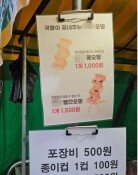Armed Forces Day showcases military strength with launch of Strategic Command
Armed Forces Day showcases military strength with launch of Strategic Command
Posted October. 02, 2024 07:34,
Updated October. 02, 2024 07:34
A series of vibrant commemorative events marked South Korea’s Armed Forces Day yesterday, featuring over 5,300 troops, 340 pieces of military equipment, and a parade through the streets of Seoul. The event saw the debut of South Korea's ultra-powerful "monster missile," the Hyunmoo-5, and a flyover by the U.S. Air Force's B-1B strategic bomber, known as the "Lancer" or "Swan of Death." In a stern warning, President Yoon Suk-yeol stated, “If North Korea attempts to use nuclear weapons, that will be the day of the regime's end.” President Yoon also highlighted the significance of the newly launched Strategic Command, which he described as a key unit for protecting the nation from North Korea's nuclear and weapons of mass destruction (WMD) threats.
Designated as a temporary national holiday, this year's Armed Forces Day allowed the public to witness the military's strength firsthand, fostering a sense of unity between civilians and service members. The parade, held for the second consecutive year, also served to bolster military morale, showcasing South Korea's formidable defense capabilities. Notably, the event displayed the Hyunmoo-5 missile, a core component of South Korea’s “massive punishment and retaliation” strategy, with its eight-ton warhead. It included the appearance of the U.S. B-1B bomber, which had flown in from Guam. These displays sent a clear warning to North Korea. In addition, the launch of Strategic Command underscored the significance of the event, serving as both a control tower to counter the North Korean nuclear program and weapons of mass destruction, and as a key pillar of the deterrence umbrella shared by Seoul and Washington.
North Korea responded swiftly. In a statement, its Ministry of Defense condemned the deployment of the B-1B and warned of "thorough retaliatory actions," adding that "new methods" would emerge accordingly, posing increased threats to U.S. homeland security. This was seen as a potential signal that North Korea could launch an intercontinental ballistic missile (ICBM) toward the Pacific on a standard trajectory in a direct provocation against the U.S. With the U.S. presidential election just a month away, South Korean and U.S. authorities have been on high alert for a possible "October surprise" from the North, maintaining a heightened state of readiness to counter any unexpected provocations.
Looking ahead, the uncertainty surrounding the post-election period in the U.S. requires further caution. Regardless of the election outcome, significant shifts are inevitable. While Vice President Kamala Harris’s policy on the Korean Peninsula remains largely undefined, former President Donald Trump’s potential return could destabilize Seoul’s deterrence strategies against North Korea. As President Yoon emphasized, “False peace based on the enemy’s goodwill is merely an illusion,” excessive reliance on alliances can pose significant risks to national security. It is a reminder of the need to strengthen Korea’s self-reliant defense capabilities to ensure overwhelming military power.
Headline News
- Joint investigation headquarters asks Yoon to appear at the investigation office
- KDIC colonel: Cable ties and hoods to control NEC staff were prepared
- Results of real estate development diverged by accessibility to Gangnam
- New budget proposal reflecting Trump’s demand rejected
- Son Heung-min scores winning corner kick







